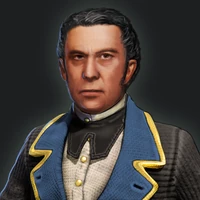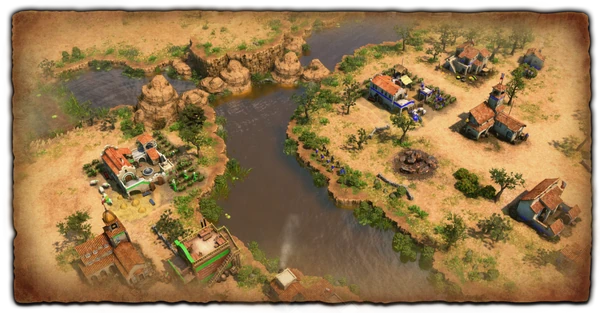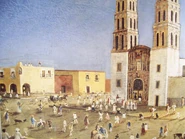| This article is about the Historical Battle scenario Grito de Dolores. For Mexican Cathedral technology, see Cry of Dolores (technology). |
Grito de Dolores (Cry of Dolores in Spanish) is the second Historical Battle introduced at the launch of Mexicans' DLC in Age of Empires III: Definitive Edition.
Summary[]
| “ | As the Bourbon Reforms granted the Spanish elite more power and diminished that of the church, resentment grew among the rural Mexican population. When news of Napoleon Bonaparte's conquest of Spain reached the Americas, the words of a Catholic priest ignited the sparks of revolution. | ” |
Scenario instructions[]
Starting conditions[]
- Starting Age:
 Exploration Age
Exploration Age - Ending Age:
 Imperial Age
Imperial Age - Starting resources: None
- Population limit: 200
- Starting units:
Objectives[]
Primary objectives[]
- Liberate a town to gain control of its buildings.
- Liberate all other towns in the region.
- Destroy both Spanish bases in the southeast mountains.
Secondary objectives[]
- Steal the Spanish food supplies.
Players[]

El Padre, protagonist of the scenario.
Player[]
- Northern Revolutionary Army (
 Mexicans): The player starts with El Padre (Miguel Hidalgo) and 22 Insurgentes in the town in the north of the map. The player must liberate the towns occupied by the Spanish until they can defeat the Spanish bases in the southeast.
Mexicans): The player starts with El Padre (Miguel Hidalgo) and 22 Insurgentes in the town in the north of the map. The player must liberate the towns occupied by the Spanish until they can defeat the Spanish bases in the southeast.
Allies[]
- Southern Revolutionary Army (
 Mexicans): The Southern Revolutionary Army it is directed by El General (Ignacio Allende) and it is located in the town on the other side of the river. In cooperative mode, the second player controls this base.
Mexicans): The Southern Revolutionary Army it is directed by El General (Ignacio Allende) and it is located in the town on the other side of the river. In cooperative mode, the second player controls this base. - Mexican Towns (
 Mexicans): The Mexican Towns are in the middle of the map occupied by Spanish troops. The player must free them to add forces, buildings and resources to his army in order to defeat the Spanish, who are southeast of the map.
Mexicans): The Mexican Towns are in the middle of the map occupied by Spanish troops. The player must free them to add forces, buildings and resources to his army in order to defeat the Spanish, who are southeast of the map.
Enemies[]
- Royalist Guards (
 Spanish): The Royalist Guards are located in the occupied towns, in the southeast guarding the Spanish Forts and northeast and southwest of the map with an Outpost with many resource crates scattered around the area. The player must defeat them to liberate the towns and can defeat them to get more resources for the battle. Consist of several Veteran Dragoons, Veteran Hussars, and Desperados.
Spanish): The Royalist Guards are located in the occupied towns, in the southeast guarding the Spanish Forts and northeast and southwest of the map with an Outpost with many resource crates scattered around the area. The player must defeat them to liberate the towns and can defeat them to get more resources for the battle. Consist of several Veteran Dragoons, Veteran Hussars, and Desperados. - Northern Royalist Army (
 Spanish): The Northern Royalist Army is located on the outskirts of the towns and in the southeast of the map with a fortified base with a Town Center and several military buildings, its army consisting of Veteran Lancers, Veteran Musketeers, Veteran Skirmishers, and Falconets.
Spanish): The Northern Royalist Army is located on the outskirts of the towns and in the southeast of the map with a fortified base with a Town Center and several military buildings, its army consisting of Veteran Lancers, Veteran Musketeers, Veteran Skirmishers, and Falconets. - Southern Royalist Army (
 Spanish): The Southern Royalist Army is located southwest of the map in a fortified area with one of the two forts (the other fort belongs to the Nothern Royalist Army) and several military buildings too. The player must destroy them to win the scenario.
Spanish): The Southern Royalist Army is located southwest of the map in a fortified area with one of the two forts (the other fort belongs to the Nothern Royalist Army) and several military buildings too. The player must destroy them to win the scenario.
Home City Cards[]
Besides the Home City Cards available in the deck given to the player, they also have access to cards gained from Federal States. The available Federal States are:
- Fortress Age: Sonora and Tabasco
- Industrial Age: Chihuahua, Zacatecas, and Guanajuato
- Imperial Age: Jalisco, Estado de México, Veracruz, and Puebla
- Click here to see an overview of all Home City Cards available in the "Grito de Dolores" Historical Battle
| Some cards are highlighted with: | |
| Green | TEAM Shipment that is sent to each player in a team |
| Purple | Shipment that can be sent an INFINITE number of times |
| Card | Description | Age |
|---|---|---|
| Dragoons get +10% attack and are now available in the Commerce Age | ||
| Heroes get +20% attack and hit points | ||
| Shipments arrive 60% faster and Cathedral technologies cost -50% | ||
| Ships 700 wood | ||
| Ships 5 Settlers | ||
| Infantry train time -40% | ||
| Ships 20 Insurgentes and Insurgentes get +20% speed; costs 400 food, 400 wood | ||
| Ships 1 Prospector Wagon; villagers gather 10% faster from mines and trees | ||
| Insurgentes get +15% attack and +5% speed | ||
| Ships 10 Insurgentes | ||
| Villagers gather food 20% faster | ||
| Artillery, Abus Guns, and grenade troopers get +15% attack | ||
| Insurgentes get +15% attack and hit points | ||
| Salteadores get +15% hit points and attack, and the Guerrilla Tactics ability | ||
| Ships 1 Factory Wagon | ||
| Ships 4 Culverins | ||
| Ships 9 Salteadores | ||
| Villagers gather 50% faster from Mills, Farms, Rice Paddies, Fields, Haciendas, and Estates | ||
| Insurgentes get a ranged attack with a musket; Insurgentes train time -20% |
Treasures[]
| Description | Reward | Guardians | Location |
|---|---|---|---|
| A stand of quaking aspen. | 40 wood | 1 |
Near the starting town |
| A stray dog in need of rescue. | 1 |
2 |
Near the first enemy town |
| A patch of potatoes. | 70 food | 2 |
Northeast, trade route's end |
| Two Eagle Warriors from the Sixth Lost City of Cibola, eager to join your side. | 2 |
3 2 |
Just south of the previous treasure |
| Porcupine with valuable quills. | 120 XP | 2 |
Southeast of previous treasure |
| A storage pit of the Second Lost City of Cibola. | 250 wood | 4 |
Southeast of previous treasure |
| Some oak trees. | 75 wood | - | East of the second enemy town in the south |
| A trapped healer, who may join the cause of a rescuer. | 1 |
2 |
Eastern section of map, northeast of previous treasure |
| Turquoise mask of the dread Aztec mummy. | 275 coin | 4 |
North section of map, across the river from the starting town |
| A healer, who will join your cause if rescued. | 1 |
2 |
Southwest of previous treasure |
| Sweet potatoes. | 70 food | 2 |
Southwest of allied army's starting town |
| A hummingbird nest. | 40 XP | 1 |
Southeast of allied army's starting town, on a cliff |
| The King's Flute of the legendary Seventh Lost City of Cibola. | Explorer and Hero: +100% hit points | 4 |
Center of the map, in the allied army's path |
| A stand of chokecherry trees bearing fruit. | 30 food | 1 |
Southwest of second enemy town across the river |
| An altar of the Third Lost City of Cibola containing gold artifacts. | 330 coin | 3 2 |
Southern corner of map |
| A den of skunks with valuable pelts. | 40 XP | 1 |
Southern section of map |
Strategy[]
| This section needs expansion. You can help by adding to it. |
The player starts with the Padre and a large number of Insurgente, which are melee infantry with weak statistics, but decent against cavalry and buildings. The starting location is a friendly Mexican town with very few buildings, lacking even a Town Center, and no remaining Settlers, as they all became insurgents. The player's ally is the Mexican General and his army, across the river, who also go from town to town liberating them from Spanish control.
The player's first neighbouring town is nearby to the south. It has an enemy Outpost with a garrison of a few cavalry like Cuatreros and infantry like Musketeers and Desperados. The player must capture the town to gain Settlers and economic buildings.
Once this is done, the player should start building up their economy, ideally by filling up the existing Hacienda and constructing another one. The player cannot yet construct Stables or Artillery Foundries, and thus lacks the ability to train cavalry and artillery.
The player will receive more primary and optional objectives. One optional objective which will be easier at this point of time is to capture the food stores near the Spanish Market in an enemy base to the northeast. The base contains a lot more enemy infantry, who might be able to wipe out the starting army, so it is necessary to wait and build up more numbers or train stronger units before this assault. Once the area is taken, the player can send Settlers to collect the five food crates, each containing 500 food, for a total of 2,500.
The next target is another enemy town to the south. While this too has just one Outpost as a defense structure, it has far more enemy units, consisting mainly of cavalry like Cuatreros and Veteran Hussars. Once this town is taken, the player gains control of another Hacienda. If the player had constructed one as advised in the previous paragraph, they will now have three, crossing the build limit of two in this scenario. The player now also unlocks the Stables and can train their own cavalry.
Taking this town also makes the path to the allied army safe, via a shallow point in the river just south of the town. The player can thus cross to the other side, and collect treasures, build Trading Posts at native settlements and trade routes, and either join up with the allied army forces to assault the enemy together or return to their own side of the river to attack the last enemy controlled town on the player's side.
The Cathedral can research a technology called Cry of Dolores, which grants an eponymous ability to the Padre which can make him heal all nearby friendly units very fast. This can be utilized in combat with great value if a lot of the player's troops receive damage. While the player cannot train artillery by normal means yet, they can still obtain them via shipments, and especially, via the Factory gained from a Factory Wagon shipment.
The next town is similar to the previous one, but with an even larger enemy force, including several Falconets. It is imperative to have a large army of strong infantry and cavalry before assaulting this town, or wait until obtaining several artillery pieces from the methods mentioned above. The player must control their cavalry to flank the enemy and destroy the Falconets instead of engaging enemy infantry.
Once this town is taken, the player can create their own Artillery Foundries to train more types of artillery at will. The last targets are the two Spanish bases in the mountains, each containing a Fort.
History[]
The Cry of Dolores, also known as "Grito de Dolores" in Spanish or "El Grito de Independencia" (The Independence Cry) by the locals, occurred in Dolores, Mexico, on September 16, 1810. Roman Catholic priest Miguel Hidalgo y Costilla rang the church bell, initiating the Mexican War of Independence.
The independence movement began when José Bernardo Gutiérrez de Lara asked the local priest, Miguel Hidalgo, for assistance in freeing New Spain from Spanish control.
Hidalgo ordered the release of pro-independence inmates, rang the church bells, and delivered a speech known as the "Cry of Dolores." Mexico adopted its official name, and after a decade of war, independence was achieved on September 28, 1821, when Agustín de Iturbide signed the Declaration of Independence of the Mexican Empire. Hidalgo is credited as the "father of his country."





